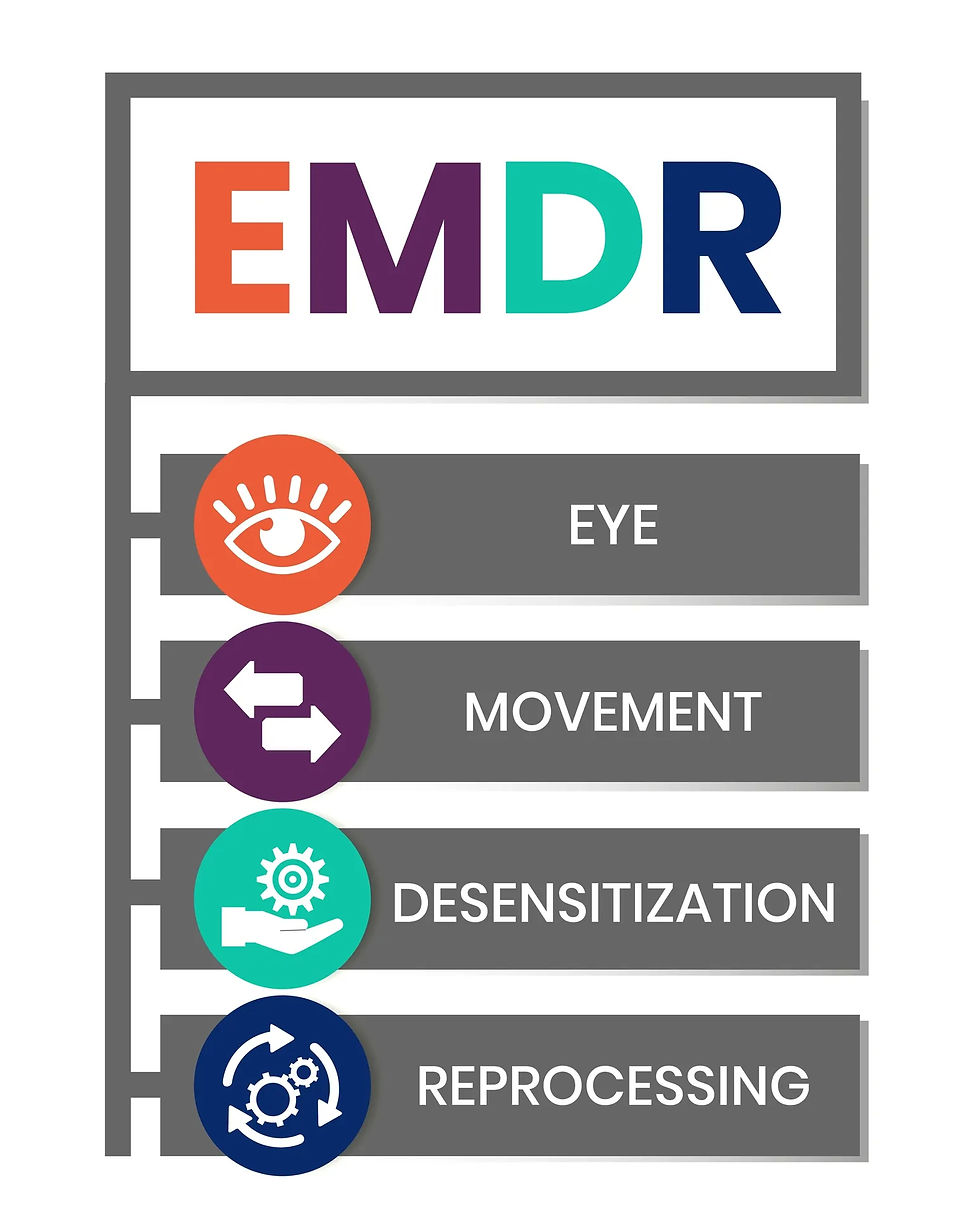Healing Trauma: What You Need to Know About EMDR Therapy
- Latise

- Oct 23, 2024
- 3 min read

From the last few weeks of blogs, we’ve gathered that life can be a lot—anxiety-filled, stressful, overwhelming, and just plain heavy. Sometimes, those experiences leave a significant impact on our lives, with lingering side effects. Enter trauma. Trauma occurs when you go through experiences so overwhelming or upsetting that your mind and body struggle to process them. This could be anything—an accident, loss, bullying, or ongoing stress. Trauma can make you feel stuck in that moment, causing lasting emotional, mental, or even physical reactions lasting weeks, months, or even years later.
What is EMDR Therapy?
EMDR (Eye Movement Desensitization and Reprocessing) might sound complex—it’s a bit of a tongue-twister, and my clients and I sometimes stumble over it—but the concept is straightforward. EMDR is a therapy designed to help people process and heal from trauma or distressing memories. Unlike traditional talk therapy (such as CBT), EMDR focuses on the brain’s natural healing processes.
And no, it’s not hypnotherapy (I get asked that a lot too, and no, I don’t do hypnotherapy!). While working with a therapist, you’ll use eye movements (or other forms of bilateral stimulation, like tapping or the “WAKANDA HUG”) to "reprocess" traumatic memories.
Traumatic memories often create stuck points, and reprocessing them allows you to look at those memories without feeling like you're reliving them.
How Does EMDR Help with Trauma?
Trauma isn’t just something that happens in our minds—it gets stuck in our bodies (as explained in The Body Keeps the Score, Bessel Van Der Kolk). When we experience trauma, our brain doesn’t always process the event fully because it’s trying to protect us from being overwhelmed. It’s like having a file open on your computer that’s never saved—the memory lingers, and it keeps you feeling stuck. That’s where EMDR comes in.
EMDR helps “close the file” on traumatic memories. By activating both sides of your brain (hence the eye movements or tapping), EMDR allows you to process the memory in a healthier way. Over time, the intense emotional charge connected to those memories fades, helping you feel more grounded and less reactive.
What Can You Expect During an EMDR Session?
If you're wondering, “Will I just be staring at a light or moving my eyes the whole time?”—kind of, but there’s more to it than that. Here’s a quick overview of what EMDR therapy typically looks like:
Preparation: Your therapist will explain the process and work with you to identify the specific trauma or memory you want to focus on. This phase also involves building rapport and gathering information.
Assessment: Together, you’ll explore themes, negative beliefs, and the memory itself, identifying what triggers strong emotions or physical sensations. Your therapist might ask you to describe how the memory feels in your body or what negative thoughts come up.
Desensitization & Reprocessing: This is the heart of EMDR. While following the therapist’s hand movements (or lights, sounds, or taps), you’ll focus on the memory. Gradually, you’ll notice the emotional charge lessening. It may feel like the weight of the memory is lifting.
Closure: You’ll wrap up each session by grounding yourself—whether through relaxation techniques or reflecting on the progress you’ve made. The goal is to leave each session feeling safe and supported.
Evaluation: In following sessions, you and your therapist will review how things are going, checking in on how the memory feels and deciding whether to move on to other areas if needed.
Why Try EMDR?
One of the best things about EMDR is that it’s fast-acting for many people. It doesn’t require years of talking about or re-living the trauma—some clients feel significant relief after just a few sessions. Plus, it’s backed by research. EMDR is recommended by organizations like the APA (American Psychological Association) and WHO (World Health Organization) for treating trauma.
Beyond the science, EMDR offers hope for those feeling stuck. Whether it’s a single traumatic event or ongoing stress, this therapy provides a new path to healing—one where you’re not just surviving your memories, but truly thriving beyond them.
The Takeaway
EMDR therapy is a powerful tool for healing trauma, offering a unique approach to processing difficult experiences. It’s not about forgetting what happened—it’s about gaining freedom from the emotional weight that those memories carry. If you’re ready to explore a different kind of therapy, EMDR might just be the next step on your healing journey. Ready to talk more about it?




Comments